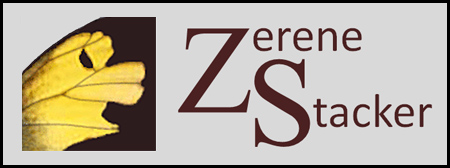Tips for Retouching
The single most commonly asked question about retouching is “How can I make retouching go faster?”
There are several different answers to this question, depending on what it is that's taking up your time.
Broadly speaking, the big recommendations are:
- Consider retouching from another output, rather than just from original source images.
For example if you're having trouble with bristles in a DMap output, then make a PMax output and retouch from that as shown in the video tutorials about retouching (HERE and HERE). If you're having problems with the “transparent foreground” artifact, then consider using Stack Selected as described HERE.
- Stroke, don't dab.
Every time you release the mouse button while brushing, there is a noticeable delay while the program finishes doing a seamless integration of what you've brushed. As a result, it's faster to retouch in long strokes using press-and-drag, as opposed to covering the same area in a “dabbing” motion by repeatedly clicking the mouse button.
- Use the fast methods for selecting source frames.
Every time you finish selecting a source file, it takes a few seconds of computation to prepare the image for use in retouching. So, the trick for fast selection is to not “finish” until you see that you're on the correct file. There are a couple of ways to do that:- Use press-and-drag in the list of Input Files, rather than press-and-release on each file. While the mouse button is held down, most of the computation is skipped so you can quickly zero in on the correct file before releasing the mouse button.
- Hover over either image window, then press and hold the Shift key while using the mousewheel, up/down arrow keys, or press-and-drag with the mouse. As long as Shift is held down, most of the computation is skipped so you can quickly zero in on the correct file before releasing the Shift key. If you have a deep stack, probably press-and-drag with the mouse will be faster because it allows skipping across input files, while using the mousewheel or up/down arrow keys will require looking at every image.
- Both of these methods rely on image caching, so be sure not to remove the checkmark on “Cache aligned screen images” at Options > Preferences > Image Caching.
- If possible, use the advanced brush types, such as “Pixels”. Compared to the default “Details” brush, the advanced brushes do a lot less computation to prepare each source image when it is finally selected. Tradeoffs are that (1) the default Details brush is better at doing seamless integration, and (2) the advanced brushes are “Pro-only” features that require Prosumer or Professional licenses for long term use. You'll have to experiment to figure out which is better overall for your situation.
Keyboard and mouse shortcuts are summarized in the table HERE.
One final note: Every once in a while somebody will run into a situation where the retouching brush does not paint as they expect. The reasons and workarounds for that issue are discussed in detail in a thread at photomacrography.net, HERE.
